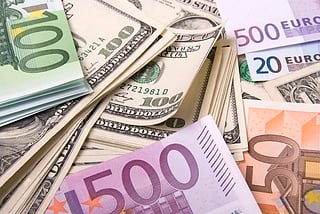EUR/USD trades near 1.0500 with bearish bias due to risk-off mood
|
- EUR/USD remains subdued as Trump’s tariff plans dampen the market sentiment.
- President-elect Donald Trump plans to impose tariffs on imports from Mexico, Canada and China.
- The Euro struggles due to growing concerns over downside risks to the Eurozone economy.
EUR/USD pares its daily losses, trading around 1.0490 during the Asian hours on Tuesday. However, the pair may continue to depreciate due to dampened market sentiment following President-elect Donald Trump’s announcement of planning to impose a 25% tariff on imports from Mexico and Canada, along with a 10% hike in tariffs on all Chinese goods entering the United States (US).
The US Dollar (USD) remains subdued following comments from Federal Reserve (Fed) officials on Tuesday. However, the USD’s downside risks are limited, supported by strong preliminary S&P Global US Purchasing Managers’ Index (PMI) data. These robust figures have strengthened expectations that the Fed may adopt a more gradual approach to further rate cuts.
Federal Reserve Bank of Chicago President Austan Goolsbee indicated that the Fed is likely to continue lowering interest rates toward a neutral stance that neither stimulates nor restricts economic activity. Meanwhile, Minneapolis Fed President Neel Kashkari highlighted that it remains appropriate to consider another rate cut at the Fed’s December meeting, according to Bloomberg.
The Euro faces pressure amid growing concerns over downside risks to the Eurozone economy. These risks stem from uncertainties related to a potential second Trump administration, the ongoing war in Ukraine, and political instability in Germany and France.
Markets have already fully priced in a 25 basis point (bps) rate cut by the European Central Bank (ECB) in December. Additionally, the likelihood of a more aggressive 50 bps rate reduction has increased to 58%, reflecting heightened market pessimism regarding the region's economic outlook.
Euro FAQs
The Euro is the currency for the 19 European Union countries that belong to the Eurozone. It is the second most heavily traded currency in the world behind the US Dollar. In 2022, it accounted for 31% of all foreign exchange transactions, with an average daily turnover of over $2.2 trillion a day. EUR/USD is the most heavily traded currency pair in the world, accounting for an estimated 30% off all transactions, followed by EUR/JPY (4%), EUR/GBP (3%) and EUR/AUD (2%).
The European Central Bank (ECB) in Frankfurt, Germany, is the reserve bank for the Eurozone. The ECB sets interest rates and manages monetary policy. The ECB’s primary mandate is to maintain price stability, which means either controlling inflation or stimulating growth. Its primary tool is the raising or lowering of interest rates. Relatively high interest rates – or the expectation of higher rates – will usually benefit the Euro and vice versa. The ECB Governing Council makes monetary policy decisions at meetings held eight times a year. Decisions are made by heads of the Eurozone national banks and six permanent members, including the President of the ECB, Christine Lagarde.
Eurozone inflation data, measured by the Harmonized Index of Consumer Prices (HICP), is an important econometric for the Euro. If inflation rises more than expected, especially if above the ECB’s 2% target, it obliges the ECB to raise interest rates to bring it back under control. Relatively high interest rates compared to its counterparts will usually benefit the Euro, as it makes the region more attractive as a place for global investors to park their money.
Data releases gauge the health of the economy and can impact on the Euro. Indicators such as GDP, Manufacturing and Services PMIs, employment, and consumer sentiment surveys can all influence the direction of the single currency. A strong economy is good for the Euro. Not only does it attract more foreign investment but it may encourage the ECB to put up interest rates, which will directly strengthen the Euro. Otherwise, if economic data is weak, the Euro is likely to fall. Economic data for the four largest economies in the euro area (Germany, France, Italy and Spain) are especially significant, as they account for 75% of the Eurozone’s economy.
Another significant data release for the Euro is the Trade Balance. This indicator measures the difference between what a country earns from its exports and what it spends on imports over a given period. If a country produces highly sought after exports then its currency will gain in value purely from the extra demand created from foreign buyers seeking to purchase these goods. Therefore, a positive net Trade Balance strengthens a currency and vice versa for a negative balance.
Information on these pages contains forward-looking statements that involve risks and uncertainties. Markets and instruments profiled on this page are for informational purposes only and should not in any way come across as a recommendation to buy or sell in these assets. You should do your own thorough research before making any investment decisions. FXStreet does not in any way guarantee that this information is free from mistakes, errors, or material misstatements. It also does not guarantee that this information is of a timely nature. Investing in Open Markets involves a great deal of risk, including the loss of all or a portion of your investment, as well as emotional distress. All risks, losses and costs associated with investing, including total loss of principal, are your responsibility. The views and opinions expressed in this article are those of the authors and do not necessarily reflect the official policy or position of FXStreet nor its advertisers.